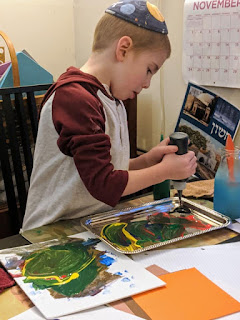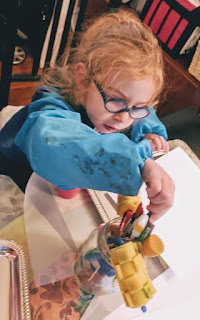My photos here and my account of setting up a home atelier are somewhat Pinterest-worthy, but let me take you on a tour of lessons learned the hard way that might not look as pretty in a photograph...
So while I nibbled and simultaneously chased after two eager artists, I tried to keep the calm and nurture the excitement. Y proceeded to squeeze every last drop of white paint onto his pallet, the table, the floor. S moved from painting a rainbow to mixing colors to making necklaces. The boys created a multitude of masterpieces and I hadn't even thought yet about how and where to display them, let alone where to set them to dry. I had four very painty hands and the lights in the bathroom were off, the door was still closed. Rookie mistake. We had a ton of painty brushes but no place to put them until we could wash them. Ok, time to provide one of those recycled plastic sushi trays. And then it was time for bed, we would try again tomorrow. I said to the boys (as much as I did to myself) that we were all new to using the atelier. It was a very special thing to have an artist's studio in our home and it was OK that we did not know everything about it yet; we would learn together.
 Day two, I set out an invitation with our book and essential question. I set out a variety of "canvases" and our paints and brushes. This time, we moved a bit more slowly and with a bit more intention, but this time it was S who became enamored with squeezing out the paints into his tray and Y who wondered how it would look and feel to squeeze them right onto some glossy finish photo paper. I had such a gut reaction to say "no" and such an urge to get to "yes." I wanted to honor their curiosity and process. I wanted to convey respect that mixing colors was as much a part of art as painting with them. I wanted not to have to buy stock in Crayola or sell a kidney on the black market in order to maintain my paint supply. Where should I draw--or paint--the line between wonder and wastefulness?
Day two, I set out an invitation with our book and essential question. I set out a variety of "canvases" and our paints and brushes. This time, we moved a bit more slowly and with a bit more intention, but this time it was S who became enamored with squeezing out the paints into his tray and Y who wondered how it would look and feel to squeeze them right onto some glossy finish photo paper. I had such a gut reaction to say "no" and such an urge to get to "yes." I wanted to honor their curiosity and process. I wanted to convey respect that mixing colors was as much a part of art as painting with them. I wanted not to have to buy stock in Crayola or sell a kidney on the black market in order to maintain my paint supply. Where should I draw--or paint--the line between wonder and wastefulness?I reached out to a teacher friend of mine who runs an atelier in her preschool. She is an artist as well and extremely talented and creative. We brainstormed ideas and she reminded me of some core atelier materials I had not remembered to include:
- Adequate time: Children need enough time to explore and engage and remain engaged with art. If they are rushed, their creative process cannot expand and it may not emerge at all. We would need to tweak the "open access" policy a bit to accommodate times when we really can engage and to be "closed" when we cannot. A large sheet or tablecloth draped over the shelves could work to visually close it off. I also like using laminated signs and velcro for this purpose. I have used this method for a while to "close" our art shelves on Shabbos or holidays. I can use it as well to close some or all of the shelves at other times as needed.
- Adequate attention: Time's kissing cousin is attention; mine was divided on the first occasion we used our atelier. In that sense, I missed an opportunity to really lay a foundation and groundwork for this space, but fear not! It's not a one shot deal! We will definitely be able to backtrack and establish a stage for this performance.
- The complete lesson: Just because you are not engaging in directed art does not mean the children do not need directions. I wanted so much for this to be their space and process that I neglected to set any boundaries at all and this was not helpful to their creative process. It actually probably inhibits it. Now we do take the time before beginning to talk and plan. It's OK if our plans change as we go and it's OK to experiment and revise. In addition to plans for preparation, giving over the complete lesson also includes establishing the skills to retrieve materials, transport them, where to use them, how to use them, how to clean them and where to put them away. I find that I nearly always leave a gap in some area or another and the children are the ones who show me where that is. It might be that I neglected to include a wet wash cloth for intermittent cleaning of hands or spills. It might be the lack of a space to set completed work to dry. It might be a very simple fix, but it can be helpful to perhaps jot these things down (unless you have an amazing memory) so that you will remember them in the future.
- Tricks and Tips: Along the way, you'll pick up tips and tricks. Some will be through trial and error. Some will be from the young artists themselves! Some will come from the creative recesses of your mind and others still will come from seeking the counsel of other atelieristas and artists. Regarding the squeeze bottle situation, my brilliant friend had several brilliant ideas. Perhaps we could add a bit of flour to thicken the paint and slow the process down. Perhaps we might draw a line on the outside of each bottle to designate a minimum point for how much paint could be used in a day or week. I proposed the idea of perhaps using a small jar and squeeze bottles to create a space where it was ok to squeeze and mix colors of paint that could then be stored and used. And then, the very next day as I sat down to continue a masterclass I am taking on process art and the atelier model, another teacher shared her trick of storing paints in empty soap bottles with pumps. The children are instructed to use two pumps at a time and can get more as needed. There you have it! For every challenge in the atelier there are infinite solutions! I ended up buying some empty pump bottles in bulk off Amazon and re-stocking our paint supply in those. And if you're looking for a tip on how to clean out the nozzles of those painty squeeze bottles: a tiny botttle brush used for baby bottle nipples or a straw brush work quite well!

- The Products of the Process: Having an atelier will undoubtedly increase your supply of art projects. I do want to give each creation the honor and respect it deserves. I usually ask the children what they would like to do with their work when they feel it's completed. Sometimes they want to hang it up. Other times they want to give it to someone special. They sometimes want to use it to make something else or store it in our "scrap paper" drawer for future use with collage. We are fortunate that although our space here is limited, we have a lot of magnetic surfaces to hang artwork and I love metal clip magnets for this purpose. The kids can hang and access their own work. We do hang and display some work on our walls and still other work is displayed on a garland with clothespins that hangs above their table. One area we are short on in our home is free horizontal surfaces to set things out to dry. Bakers racks stacked on top of one another can help with this challenge as well. And what to do with the overflow of projects over time? Do you save every single creation? Toss them when no one is looking? I like to select some very special ones, take photos of others and upcycle others into new artwork. Sometimes we give work away to a grandparent and sometimes we cut it into pieces for collage or to create greeting card sets as gifts or even to make bookmarks or labels. You might even use a blank journal or sketch book to store small pieces of artwork or photos of larger ones so young artists can maintain a timeline of their experience and growth in the atelier.
- Using Resources and Literature for Inspiration: While I love for the children to independently create using their own ideas and imagination, I also like to incorporate provocations and invitations to inspire them. Using children's literature, especially some of the great choices out there on the topic of art and artists, can be a great starting place. Pinterest, Instagram and similar sites offer a lot of tried and true ideas from others. Incorporating art books and works of art from "real" artists and even photographs and coffee table books with animals, nature and other items of interest to your children at the time can also offer inspiration and a starting place for those who may be overwhelmed by Blank Canvas Syndrome. Sometimes these items may just be set up or set out in our space and at other times I may introduce a more formal activity with them, as I did with I Ain't Gonna Paint No More.
Happy Playing!



No comments:
Post a Comment